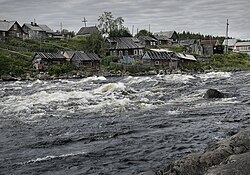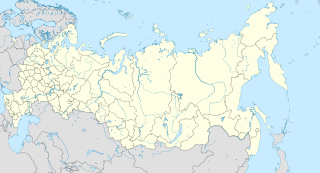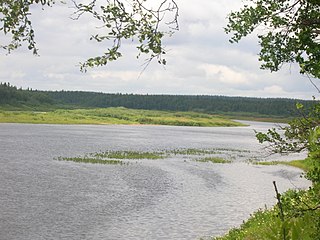
The White Sea is a southern inlet of the Barents Sea located on the northwest coast of Russia. It is surrounded by Karelia to the west, the Kola Peninsula to the north, and the Kanin Peninsula to the northeast. The whole of the White Sea is under Russian sovereignty and considered to be part of the internal waters of Russia. Administratively, it is divided between Arkhangelsk and Murmansk Oblasts and the Republic of Karelia.

Yokanga River is a river in the north of the Kola Peninsula in Murmansk Oblast, Russia. It is 203 km in length. The area of its basin is 6,020 km². The Yokanga River originates in Lake Alozero and flows into the Barents Sea. Its biggest tributary is the Sukhaya River. The river's indigenous Sami inhabitants have traditionally spoken the Ter Sami language. However, in the 1930s the largest Ter Sami village, Yokanga, was declared "perspectiveless" by the Soviet authorities and its inhabitants were forced to move to the Gremikha military base.

The R21 highway, also known as the Kola Motorway, is a major highway in Russia, running from Saint Petersburg to Murmansk. The highway is part of the E105 European route. The highway is the main transportation route by road in the Republic of Karelia and the Murmansk Oblast. Its length is 1592 kilometers.

The Tuloma River is a river in Murmansk Oblast in Russia. With a drainage basin of 21,500 square kilometres (8,300 sq mi) and an average discharge at 255 m³/s, the Tuloma is one of the biggest rivers in northern Fennoscandia.

for the stream in Israel, see Nahal Qana

Muna is a 45 km long river in the southwestern part on the Kola Peninsula, Murmansk Oblast, Russia. The Muna is a tributary to the Umba River. Its source is Lake Munozero, about 30 km east of Lake Kanozero. From there it flows towards the west, following a winding course through a sparsely populated, hilly landscape dominated by forests and bogs. A substantial tributary, the Inga River, flows into the Muna from the north. The Munas outlet is at the eastern bank of Lake Kanozero, about 8 km southeast of where the main Umba River falls into the same lake.
Lake Lupche is a small lake on the Kola Peninsula, Murmansk Oblast, Russia near Kandalaksha. It has an elevation of 23.1 m. Lupche-Savino River flows from the lake.

Kovda River is a river in the south of the Kola Peninsula in Murmansk Oblast and Republic of Karelia, Russia. It is 233 kilometres (145 mi) long, with a drainage basin of 26,100 square kilometres (10,100 sq mi). The Kovda River originates in the Lake Topozero and flows through the lakes Lake Pyaozero and Lake Kovdozero into the Kandalaksha Gulf.

Vuosnayoki River is a river in the south of the Kola Peninsula in Murmansk Oblast, Russia. It is 66 kilometers (41 mi) in length. The river flows into the Lake Nivajärvi.

Lupche-Savino River is a river in the south of the Kola Peninsula in Murmansk Oblast, Russia. It is 15 km in length. The Lupche-Savino River originates in the Lake Bolshoye Savino and flows into the Lupcha Bay of Kandalaksha Gulf.

Kolvitsa River is a river in the south of the Kola Peninsula in Murmansk Oblast, Russia. It is 12 km in length. The Kolvitsa River originates from the Lake Kolvitskoye and flows into the Kolvitskaya Bay, Kandalaksha Gulf, White Sea near the village of Kolvitsa.

Tersky District is an administrative district (raion), one of the six in Murmansk Oblast, Russia. Municipally, it is incorporated as Tersky Municipal District. It is located in the south of the Kola Peninsula and borders the White Sea in the south. The area of the district is 19,300 square kilometers (7,500 sq mi). Its administrative center is the urban locality of Umba. District's population: 6,288 (2010 Census); 7,434 (2002 Census); 9,752 (1989 Census). The population of Umba accounts for 88.0% of the district's total population.
Murmansk Governorate was an administrative division of the early Russian SFSR which existed in 1921–1927. The governorate was established on the territory of former Alexandrovsky Uyezd of Arkhangelsk Governorate by the All-Russian Central Executive Committee (VTsIK) Decree issued on June 13, 1921. The administrative center was in Murmansk.
























